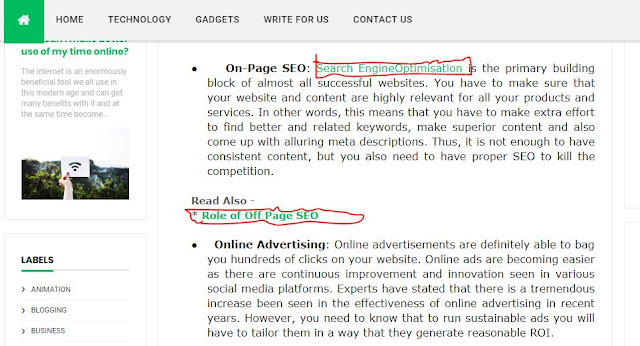Back-link is the most important and difficult term in SEO. Back-link helps to increase
link juice as well as increase rank in search engine. We basically see two
types of back-link, one is internal and another is external back-link. Both are
crucial to rank a site. In this article, I will discuss about the important and
process of internal back-link.
What is Internal Link Building or Internal Back-link?
When
linking is occurred from on page to another at same website, it is called
internal link. That means doing linking among different pages with relevant
content at one domain.
In the picture, we can see two colored anchor texts, both of which are linked to another page of the same website. See the live demo from the post of ‘ways to boost the web traffic’.
Otherwise,
external link building is a strategy to link own site to another site. That means
doing linking between different domains but as a relevant topic.
For example, in this blog post, I recommended here a top-class SEO service provider. Herewith the anchor
text ‘SEO service provider’ I used a hyperlink on an external domain which is
called an external backlink for the second domain. But we should remember that both
articles will be on the same topic.
Why We Should Do Internal Backlink?
·
It passes link juice or authority among the pages of the same a domain which indicates search optimization.
·
It navigates visitor to another relevant page and guides
visitors to the most valued pages which help to reduce site’s bounce rate as
well. Because of this process, Google bot receives usability signals from
traffic. It indicates the usability of a website to search engines.
·
It helps to optimize conversion rate providing ‘calls to
action’ link which is called conversion optimization.
What should the internal back-link look like – Do follow or No-follow?
Internal back-link can be do-follow or no-follow. Do follow links have value to the
search engine. When the search bot comes across the website, it checks all links
which are do-follow and passes some link juice or authority to the second page.
That’s why we should put a do-follow back-link when we link an important page so
that the search bot can pass authority from one page to another.
One the issue should be concerned according to the purpose of linking any pages with do-follow that both pages should have a similar topic. Otherwise, the search bot takes
it negatively and left a bad rating to the site.
Internal back-link shouldn’t be always do-follow. Because all pages of our site don’t have
equal value. There will be some pages with irrelevant content or less valued
content, such as call-to-action type’s pages. For this type of page that is not
relevant, we should keep it no-follow.
See
the image in below, this types of ‘calls to action button should be kept
no-follow hyperlink.
Internal Back-link Setup Strategy
At
the time of focusing on internal link building, you have to make a crystal clear
strategy so that Google can understand the relevancy, relationship, and value of
the pages. It is a very crucial part of on-page SEO. You can make a diagram of the internal back-link before applying the technique.
Add contextual links – It is the most popular
technique to link another page. In the article, you have to choose a phrase
that is related to the recommended page anchoring with the link of the targeted
page. When the search bot passes the page, it can read the link with these anchor
words and left some value for the targeted page. You can use these contextual
links when you want that Google knows your cornerstone article for giving
priority.
Add a related post section – If you are using
WordPress, you will find many plugins that shows related post. Install one of
the plugin and place it on below of the content. Make sure that the plugin
truly shows the relevant content; otherwise it is better to make it manually.
Add navigational links – you can link your
cornerstone content on the top mean. You should add the most important pages to
the navigation which helps to increase more authoritative to Google’s eyes.
Add taxonomies links – Your taxonomies links
will help Google to understand better about the structure of your site.
Taxonomies mean to get link from categories and tags. You should try to do
manual category listing by adding taxonomies links that gives very high
authoritativeness for the certain post.
Add links to recent or popular posts
section –
probably you notice that many websites have a sidebar contain with popular post
or recent posts. You can do it by installing plugin. But I suggest you to do it
manually and put here your cornerstone post which you want to rank on search
engine.
Following
a solid linking strategy you can rank your site easily. Therefore, do a proper
internal linking strategy for getting result. Happy Blogging!




The blog is unique that’s providing the nice material. Please post more interesting articles here.
ReplyDeletetop UX agencies